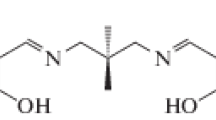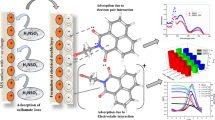Abstract
J55 steel is widely used in the oilfield for construction of wellbore, casings, tubular and pipe work but usually corroded by acidic treatment fluids. Corrosion inhibitors are usually added to the fluid to reduce the rate of corrosive attack. The influence of clomipramine (CLO) on the corrosion behaviour of J55 steel in 1 M and 15% HCl has been investigated using thermogravimetric, impedance, polarization, spectroscopic and surface analytical techniques. The highest concentration of CLO tested (10 × 10−5 M) was 85.6 and 73.2% efficient in 1 M and 15% HCl, respectively, at 30 °C. Inhibition efficiency declined as temperature increased, but the efficiency was optimized by blending it with intensifiers: potassium chloride (KI), polyethylene glycol (PEG), sodium gluconate (NaG) and glutathione (GLU). On addition of KI, PEG, NaG and GLU, inhibition efficiency increased to 92.8, 90.1, 96.4 and 98.3%, respectively, at 30 °C. Impedance measurement shows that increase in CLO concentration increased charge transfer resistance and decreased double-layer capacitance. Polarization study reveals that CLO acts as a mixed-type inhibitor that is spontaneously chemisorbed on J55 steel as described by Temkin adsorption model. FTIR, EDAX and quantum chemical studies support that N atoms and aromatic rings constitute the active adsorption sites in CLO. Inhibition was enhanced by formation of complex protective CLO film on the steel surface as predicted from UV–visible and SEM studies.
Graphical Abstract












Similar content being viewed by others
References
Kalfayan LJ (2008) Production enhancement with acid stimulation, 2nd edn. PennWell Books, Tulsa
Maly GP (1976) Method of acidizing wells. U.S. Patent 3,998,272
Kelland MA (2014) Production chemicals for the oil and gas industry. CRC Press, Boca Raton
Rae P, Lullo GD (2003) Matrix acid stimulation—a review of the state-of-the-art. In: SPE European formation damage conference. Society of Petroleum Engineers
Dariva CG, Gallio AF (2014) Corrosion inhibitors–principles, mechanisms and applications. Dev Corros Prot, InTech. doi:10.5772/57255
Farsak M, Keles H, Keleş M (2015) A new corrosion inhibitor for protection of low carbon steel in HCl solution. Corros Sci 98:223–232
Kumar H, Sappani KS (2013) Torsemide and furosemide as green inhibitors for the corrosion of mild steel in hydrochloric acid medium. Ind Eng Chem Res 52(22):7457–7469
Olasunkanmi LO, Obot IB, Kabanda MM, Ebenso EE (2015) Some quinoxalin-6-yl derivatives as corrosion inhibitors for mild steel in hydrochloric acid: experimental and theoretical studies. J Phy Chem C 119(28):16004–16019
Zhang X, Zheng Y, Wang X, Yan Y, Wu W (2014) Corrosion inhibition of N80 steel using novel diquaternary ammonium salts in 15% hydrochloric acid. Ind Eng Chem Res 53(37):14199–14207
Yadav M, Kumar S, Purkait T, Olasunkanmi LO, Bahadur I, Ebenso EE (2016) Electrochemical, thermodynamic and quantum chemical studies of synthesized benzimidazole derivatives as corrosion inhibitors for N80 steel in hydrochloric acid. J Mol Liq 213:22–138
Verma C, Singh P, Quraishi MA (2015) A thermodynamical, electrochemical and surface investigation of Bis (indolyl) methanes as Green corrosion inhibitors for mild steel in 1 M hydrochloric acid solution. J Assoc Arab Univ Basic Appl Sci 21:24–30
Verma C, Quraishi MA, Singh A (2016) 5-Substituted 1H-tetrazoles as effective corrosion inhibitors for mild steel in 1 M hydrochloric acid. J Taibah Univ Sci 10(5):718–733
Sastri VS (2012) Green corrosion inhibitors: theory and practice, vol 10. Wiley, Hoboken
Umoren SA, Eduok UM (2016) Application of carbohydrate polymers as corrosion inhibitors for metal substrates in different media: a review. Carbohydr Polym 140:314–341
Xhanari K, Finšgar M (2016) Organic corrosion inhibitors for aluminum and its alloys in chloride and alkaline solutions: a review. Arab J Chem. doi:10.1016/j.arabjc.2016.08.009
Zaferani SH, Sharifi M, Zaarei D, Shishesaz MR (2013) Application of eco-friendly products as corrosion inhibitors for metals in acid pickling processes—a review. J Environ Chem Eng 1(4):652–657
Tiu BD, Advincula RC (2015) Polymeric corrosion inhibitors for the oil and gas industry: design principles and mechanism. React Funct Polym 95:25–45
Finšgar M, Jackson J (2014) Application of corrosion inhibitors for steels in acidic media for the oil and gas industry: a review. Corros Sci 86:17–41
Anupama KK, Ramya K, Shainy KM, Joseph A (2015) Adsorption and electrochemical studies of Pimenta dioica leaf extracts as corrosion inhibitor for mild steel in hydrochloric acid. Mater Chem Phys 167:28–41
Deyab MA (2015) Egyptian licorice extract as a green corrosion inhibitor for copper in hydrochloric acid solution. J Ind Eng Chem 22:384–389
Ituen E, Akaranta O, James A (2016) Green anticorrosive oilfield chemicals from 5-hydroxytryptophan and synergistic additives for X80 steel surface protection in acidic well treatment fluids. J Mol Liq 224:408–419
Ituen EB, James AO, Akaranta O (2016) Fluvoxamine-based corrosion inhibitors for J55 steel in aggressive oil and gas well treatment fluids. Egypt J Pet. doi:10.1016/j.ejpe.2016.10.002
Kellner M (2010) Drug treatment of obsessive-compulsive disorder. Dialogues Clin Neurosci 12(2):187–197
Pittenger C, Kelmendi B, Bloch M, Krystal JH, Coric C (2005) Clinical treatment of obsessive compulsive disorder. Psychiatry 11(2):34–40
Schachter M, Parkes JD (1980) Fluvoxamine and clomipramine in the treatment of cataplexy. J Neurol Neurosurg Psychiatry 43(2):171–174
Garverick L (ed) (1994) Corrosion in the petrochemical industry. ASM, Washington
Ahmad Z (2006) Principles of corrosion engineering and corrosion control. Butterworth-Heinemann, Oxford
Sulaiman KO, Onawole AT (2016) Quantum chemical evaluation of the corrosion inhibition of novel aromatic hydrazide derivatives on mild steel in hydrochloric acid. Comput Theor Chem 1093:73–80
Aldana-González J, Espinoza-Vázquez A, Romero-Romo M, Uruchurtu-Chavarin J, Palomar-Pardavé M (2015) Electrochemical evaluation of cephalothin as corrosion inhibitor for API 5L X52 steel immersed in an acid medium. Arab J Chem. doi:10.1016/j.arabjc.2015.08.033
Odewunmi NA, Umoren SA, Gasem ZM (2015) Utilization of watermelon rind extract as a green corrosion inhibitor for mild steel in acidic media. J Ind Eng Chem 21:239–247
Pavithra MK, Venkatesha TV, Punith Kumar MK, Anantha NS (2016) Electrochemical, gravimetric and quantum chemical analysis of mild steel corrosion inhibition by colchicine in 1 M HCl medium. Res Chem Intermed 42(3):2409–2428
Nwankwo LI, Shehu AT (2015) Evaluation of Curie-point depths, geothermal gradients and near-surface heat flow from high-resolution aeromagnetic (HRAM) data of the entire Sokoto Basin, Nigeria. J Volcanol Geotherm Res 305:45–55
Akpabio IO, Ejedawe JE, Ebeniro JO, Uko ED (2003) Geothermal gradients in the Niger Delta Basin from continuous temperature logs. Glob J Pure Appl Sci 9(2):265–272
Adedapo JO, Ikpokonte AE, Schoeneich K, Kurowska E (2014) An estimate of oil window in Nigeria Niger Delta Basin from recent studies. Gas 5(11):12–18
Umoren SA, Ebenso EE (2007) The synergistic effect of polyacrylamide and iodide ions on the corrosion inhibition of mild steel in H2SO4. Mater Chem Phys 106(2):387–393
Şahin M, Bilgic S, Yılmaz H (2002) The inhibition effects of some cyclic nitrogen compounds on the corrosion of the steel in NaCl mediums. Appl Surf Sci 195(1):1–7
Matad PB, Mokshanatha PB, Hebbar N, Venkatesha VT, Tandon HC (2014) Ketosulfone drug as a green corrosion inhibitor for mild steel in acidic medium. Ind Eng Chem Res 53(20):8436–8444
Raveendra RS, Prashanth PA, Nagabhushana BM (2016) Synthesis and spectral characterization studies of bio-active cobalt(II) complexes with clomipramine ligand. J Adv Chem Sci 2(3):334–336
Kumar S, Sharma D, Yadav P, Yadav M (2013) Experimental and quantum chemical studies on corrosion inhibition effect of synthesized organic compounds on N80 steel in hydrochloric acid. Ind Eng Chem Res 52(39):14019–14029
Madkour LH, Kaya S, Kaya C, Guo L (2016) Quantum chemical calculations, molecular dynamics simulation and experimental studies of using some azo-dyes as corrosion inhibitors for iron. Part 1: mono-azo dye derivatives. J Taiwan Inst Chem Eng 68:461–480
Acknowledgements
The authors acknowledge gratefully the financial support of World Bank RSM Fellowship 2015 to carry out this research abroad. EI acknowledges Dr. Shuangqing Sun, the host at Corrosion Protection Research Group of Department of Materials Physics and Chemistry, China University of Petroleum, Qingdao, for providing facilities and software for this research.
Author information
Authors and Affiliations
Corresponding author
Ethics declarations
Conflict of interest
On behalf of all authors, the corresponding author states that there is no conflict of interest.
Rights and permissions
About this article
Cite this article
Ituen, E., Akaranta, O. & James, A. Influence of Clomipramine-Based Blends on Corrosion Behaviour of J55 Steel in Simulated Oilfield Acidizing Solution. J Bio Tribo Corros 3, 23 (2017). https://doi.org/10.1007/s40735-017-0082-3
Received:
Revised:
Accepted:
Published:
DOI: https://doi.org/10.1007/s40735-017-0082-3




